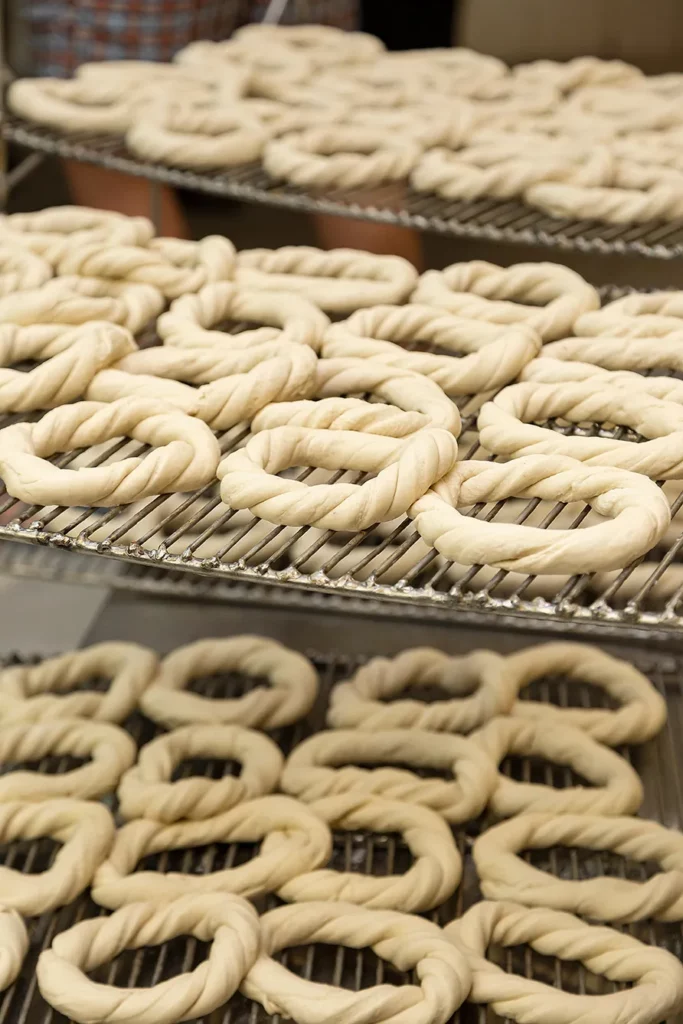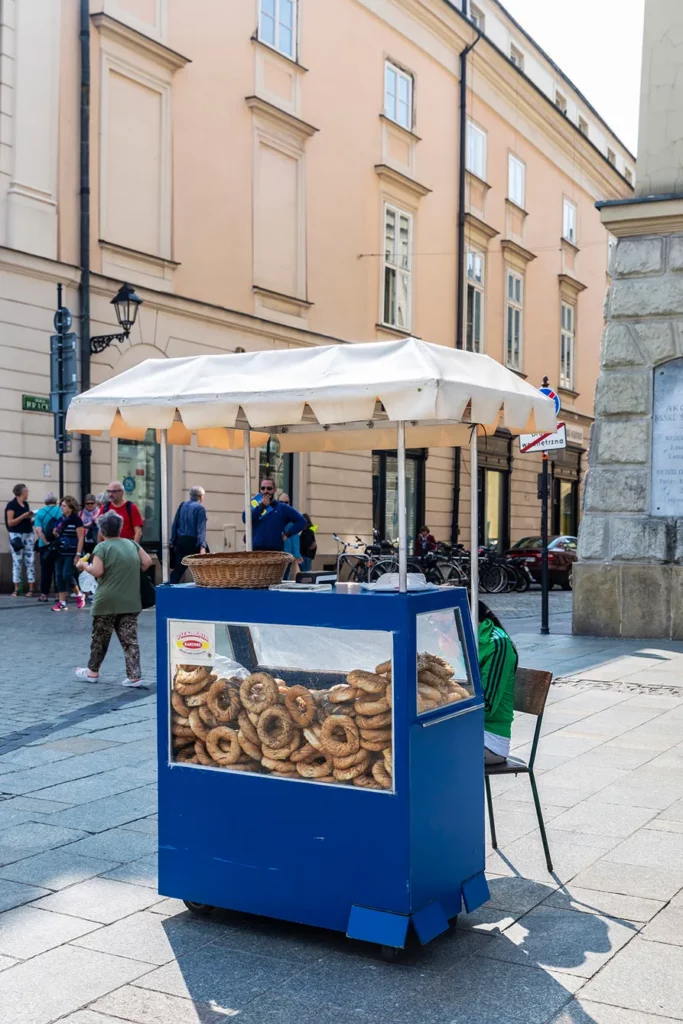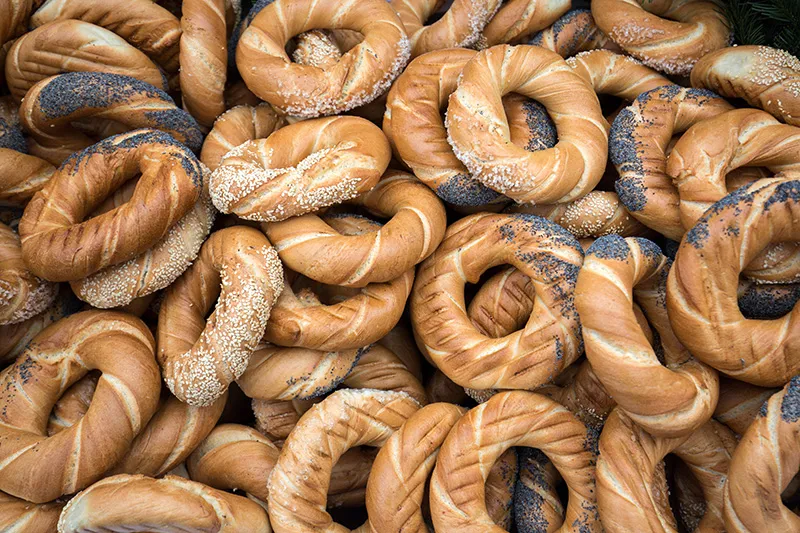Cracow is undoubtedly one of Poland’s most beautiful and historic cities. It is a stronghold of artists, intellectuals, and entrepreneurs alike. The city’s unique character encapsulates the historical richness that keeps the visitors coming and… returning. A trip to Cracow would not be complete if you weren’t to try an obwarzanek (or the plural form: obwarzanki).
This baked treat resembling a bagel is available at virtually every bakery and street corner, sold by vendors showcasing delicious obwarzanki in their specially-designed glass trolleys. The obwarzanek business in Cracow is serious. This bun is no ordinary snack. Its documented history goes back over 700 years. It frequented the royal courts and has always been a source of pride for the merchants who were allowed to produce them.
Pedigreed goods
The obwarzanek was first mentioned in historical sources in 1257 in an ordination document, establishing the location of the city of Cracow under new Medieval laws. The document was passed by Bolesław the Chaste and, among other things, allowed bakers to sell their goods (such as obwarzanki) in the city’s main square. Such was the fame of the obwarzanek that it made its way to the royal court.



It is known from the preserved books of King Jadwiga’s expenses that she had a soft spot for the Cracovian delicacy. One of the entries from 1394 mentions that King Jagiełło and Jadwiga purchased obwarzanki for their subjects. How generous!
As with every successful product, obwarzanki gave rise to bodgers and conners, who cared little for the art. Of making the goods, but wanted the money obwarzanki brought. Eventually, the situation required royal intervention. In 1496 king John I Albert granted the privilege to Cracovian bakers that made them the exclusive, rightful manufacturers of obwarzanki. Starting from the 17th century up until the early 19th century, the bakers were closely monitored and controlled by the city’s authorities, who checked their production process and all necessary approvals. The reports and books from these visits survive to this day.
Beware of forged obwarzanki
Starting from the 19th century, obwarzanki were sold out of willow baskets. This mode of merchandise lasted until the 1950s when the baskets were exchanged for the glass trolleys you can so frequently spot when strolling down the streets and alleys of Cracow. But do you think any royal decrees, laws, regulations, or even the seal of Certified Geographical Origin awarded to the obwarzanek by the European Union in 2010 stopped the greedy bodgers from trying to feed the poor unaware souls with their fake products? Of course not!
Alas, forgeries are very common, especially if you take into account that only eight (!) Cracovian bakeries are certified to bake the authentic, traditionally-made product. Fear not, however, as there’s an easy trick to tell the fakes from the originals. The secret is embedded in the obwarzanek’s bottom part. The originals have lines made during production (from the grate). In contrast, the forged ones have round marks left by the machines used in mass production.
All’s well, but what the heck does obwarzanek mean?
The name obwarzanek [pronounced something like: oo-bva-scha-neck] comes from the way it is produced. It is said to be the only food that is… boiled before being baked! There is a method in this madness – boiling kills the yeast used as a raising agent for the dough. The process prevents the pastry from rising in the oven. It then preserves a lush, fluffy inside surrounded by brown, crispy outside. Yuuum!
And that is the whole origin of the name. The Polish word obwarzać means to boil something. And as the rolls are boiled… there you have it. Cracovians claim this is the only baked roll in the world prepared in this way (boiling+baking).
Six ingredients of success
The recipe for the dough is extremely simple. It involves six basic ingredients (flour, yeast, salt, sugar, water, and fat – often oil), which make for a nice, sticky dough. The dough is rolled into a thin… well, roll… and then cut into even stripes. Two stripes are joined together, weaved around one another, boiled, sprinkled (or dipped by the professional bakers, which explains why they have the sprinkles only on one side) with salt, poppy seeds, or sesame seeds, and baked for about 10 minutes. Obwarzanki taste best for the first few hours after being taken out of the oven, as they quickly dry out. That’s why you can buy them every day – freshly made and (if you’re lucky) still warm. And you can eat the real deal only in Cracow!
Mind your words!
Now for the terrible faux pas. Never, ever, EVER call the obwarzanek a bagel or a pretzel! These are two completely different and differently made baked goods with their long-standing history. Truth be told, due to the partitions and influence of the Austrian occupation, and possibly due to the conners selling krakowski precel (*’precel’ being the phonetic Polish spelling for ‘pretzel’) instead of the real product – krakowski obwarzanek, some Cracovians can be overheard calling their own national produce, pretzels.
But that’s naughty, and we should be kind enough to pretend we didn’t hear it. They just might (and should!) blush bright red and drop their obwarzanek on the ground. And that would be simply wasteful.







